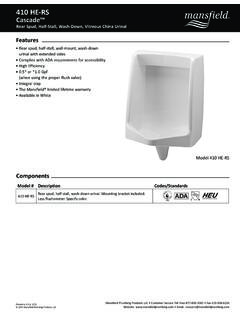Transcription of How T o Select The Right High Stall Converter - TCS Products
1 The basic purpose of installing a modified torque Converter is to allow the engine (RPM) to increase to where the engine is making greater power before driving the wheels, thus allowing the vehicle to accelerate from a standing start much the correct Stall for a Converter is critical to gaining the best performance possible for an intended use. The powerband or operating range of the engine is influenced by the camshaft design, carburation, manifold and head flow, the Converter must be designed to work within this range to deliver the best performance of a vehicle with a higher Stall speed can be substantially reduced with a poorly designed torque Converter . Excessive heat generating slippage and rpm flair up can make street driving miserable and costly with a Converter that is too TORQUE CONVERTERS are designed to provide the rpm launch best suited to the torque band of your engine without excess slippage throughout the power range.
2 Reducing slippage after the launch, more torque can be used to power the vehicle. This design delivers increased miles per hour without rpm increase, reducing heat and excessive engine stand up to the demands of heavy duty, high performance and competition applications, TCS converters receive extensive alterations to many of the internal components to deliver the most accurately assembled Converter in the WHICH Converter IS BEST FOR YOUR APPLICATION1- Maximum performance can only be obtained when the total combination of engine components are matched to work Determine the Converter Stall speed requirements based on the powerband of your Determine the type of transmission to be Order your Converter after you know all of the engine and driveline specs that will affect the Stall speed a general rule for street use, obtain a Stall speed with a minimum of 500 rpm into the powerband.
3 This will allow your engine to get into the area where it is designed to operate and your engine will make enough power to drive the Converter into its' Stall range. Race applications require a minimum of 1000 rpm more Stall up to as much as the peak torque range for all out 604-533-8675 Toll Free - 205th Street, Langley, BC, Canada V2Y 1N7 QUICK SELECTION CHART- to assist in selecting your Converter . Call Steve or Paul at TCSA dvertised Camshaft Duration Operating Range Cruise RPM @ 60 MPH Recommended (Powerband RPM) (100 km/h) Converter 1200 - 2000 - 2000 - 1600 - 2200 - 2000 - 2000 - 2500 - 2500 - 2200 - 2600 - 2400 - 2700 - 3000 - 3000 - 3500 - 3500 - 4200 - 4000 - 4500 Page 1 HOW TO Select THE RIGHTHIGH Stall CONVERTERM anufactured In-House by TCS ProductsToll Free: 1-800-960-1177 Click here to visit our website Torque Converter OperationThe automatic transmission torque Converter comprises four main elements.
4 The impeller (also known as the pump assembly), turbine, stator and housing. Lockup converters contain a clutch pressure plate unit as a fifth element. The ImpellerThis is the Converter 's driving section which consists primarily of curved blades placed uniformly on the inside cover. As the impeller rotates, fluid is thrown through the curved fluid passages and into the turbine by centrifugal TurbineThis is the driven or output member of the Converter . The design of the turbine is similar to that of the impeller except that the blades are curved in the opposite direction. Fluid from the impeller strikes the turbine blades causing the turbine to rotate and drive the input shaft. The fluid leaves the turbine and returns to the impeller through a third set of blades known as the StatorThis is the Converter reaction section.
5 Contains a one-way clutch which permits the stator to rotate only in the same direction as the impeller. The clutch locks the stator to the stator support to prevent the reversal of Converter Operation:The torque Converter is designed so the fluid flows from the impeller to the turbine then back to the impeller through the stator. This flow produces a maximum torque increase of 2:1 when the turbine is stalled. When enough torque is developed by the engine and the Converter , the turbine begins to rotate and turns the transmission input Converter torque multiplication gradually tapers off as the turbine speed approaches impeller speed and becomes 1:1 when the turbine is being driven at 9/10 impeller speed.
6 This is called the point of the turbine is operating at less than 9/10 impeller speed and the Converter is multiplying torque, the fluid leaving the turbine blades strikes the front plate of the stator blades. These blades are held stationary by the action of the one-way clutch as long as the fluid is directed against the front face of the the turbine rotates faster than 9/10 impeller speed and the Converter no longer multiplies torque, the fluid is directed against the back face of the stator blades. Since the one-way clutch permits the stator to rotate only in the direction of the impeller rotation, the stator begins to turn with the impeller and turbine. The Converter is now an efficient fluid coupling as long as the turbine speed remains greater than 9/10 impeller Converter Operation:Worldwide, vehicle manufacturers have developed designs to take the 9/10 efficiency and increase it to 10/10 by the addition of a mechanism (clutch pressure plate) that connects the front of the Converter mechanically to the turbine and thus to the input shaft.
7 Most of these systems function by fluid flow through the torque Converter that is controlled by the transmission itself or by electronics or on board the signal from the transmission changes the flow from the centre of the turbine shaft to the outside of the stator support, lockup occurs. Whenever oil flows through the centre of the turbine shaft, out of the Converter , through the stator support and into the cooler, the Converter is in a non-lockup mode. The exception to this is the infrequently used centrifugal lockup type which is applied by a combination of weights and centrifugal Free : Illustration shows all components as viewedfrom transmission end of torque converterPage 2 Toll Free: 1-800-960-1177 Click here to visit our website






